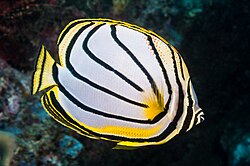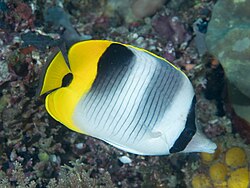Top Qs
Timeline
Chat
Perspective
Chaetodon
Genus of fishes From Wikipedia, the free encyclopedia
Remove ads
Chaetodon is a tropical fish genus in the family Chaetodontidae. Like their relatives, they are known as "butterflyfish". This genus is by far the largest among the Chaetodontidae, with about 90 living species included here,[1] though most might warrant recognition as distinct genera.
Remove ads
Taxonomy
Summarize
Perspective
Proposed subgenera
Several subgenera have been proposed for splitting out of this group. It is becoming clear how the genus might be split up, with a range[2][3] of DNA sequence data in large parts agreeing with S.D. Blum's landmark 1988 phylogenetic assessment of osteology.[4]
Basically, a core group around the type species Chaetodon capistratus would remain in Chaetodon, while maybe four clades would be split off. These could use the names Lepidochaetodon, Megaprotodon and Rabdophorus, and there is one unnamed group containing the three-banded butterflyfish (C. robustus) and its relatives. But the monophyly of the Lepidochaetodon group is not fully established; it is both unclear whether Rhombochaetodon is a lineage distinct from Exornator, and whether Lepidochaetodon is indeed closer to these than to any other Chaetodon, particularly to some lineages otherwise placed in Megaprotodon.[2]
Prognathodes, for some time contained in Chaetodon, is worthy of recognition as full genus, as is Roa.[5]
Historically, more distantly related fish were placed in Chaetodon too, for resembling them in details – e.g. the common scat Scatophagus argus, which has a similar shape and size, as well as armored larvae like the Chaetodontidae – or simply because they are colorful, smallish, and unusual-looking – e.g. the quite unrelated paradise fish, as C. chinensis.
The classification proposed in Fessler and Westneat is based on the species of Chaetodon they sampled and these sorted into the following clades:[2]
Remove ads
Extant species
Summarize
Perspective
There are currently 87 recognized species in this genus:[6]
Chaetodon sensu stricto
C. robustus group
Lepidochaetodon group
*Nota bene: including Burgessius, Heterochaetodon and possibly Rhombochaetodon; tentatively placed here.
*Nota bene: including Tifia. C. daedalma, C. litus, C. nippon, and C. smithi are tentatively placed here.
Nota bene: including Roaops, might belong in Exornator; tentatively placed here. C. blackburnii, C. declivis, C. flavocoronatus, C. mitratus, and C. tinkeri tentatively placed here.
Megaprotodon group
Nota bene: tentatively placed here.
Nota bene: tentatively placed here.
Nota bene: C. tricinctus tentatively placed here in Discochaetodon.
Nota bene: tentatively placed here.
Nota bene: C. andamanensis is tentatively placed here in Tetrachaetodon.
Rabdophorus group
Nota bene: Including Aspilurochaetodon and Chaetodontops. C. auripes, C. gardineri, C. leucopleura, C. nigropunctatus, and C. xanthocephalus are tentatively placed in this group.
Incertae sedis
Nota bene: most are probably either Chaetodon sensu stricto or C. robustus group.
Remove ads
Fossil species

The following fossil species are known:[7]
- Subgenus †Arambourgchaetodon[8]
- Subgenus †Blumchaetodon
- †Chaetodon wattsi Marramà, Giusberti & Carnevale, 2022 (Early Oligocene of Italy)
The species Chaetodon penniger Bogachev, 1964 from the late Oligocene of Azerbaijan cannot be confidently assigned to this genus due to the incompleteness of the fossil.[7]
Evolution & fossil record

The earliest confirmed specimens of Chaetodon are from Early Oligocene-aged coral reef deposits of Italy, belonging to the extinct species Chaetodon wattsi. This fossil is roughly concurrent when the family is thought to have radiated into its modern genus diversity. Indeterminate Chaetodon fossil specimens (including both articulated specimens and otoliths) referred to Chaetodon hoefleri are known from the Late Oligocene of Slovenia and the mid-late Miocene of Poland.[7]
As it is not easy to distinguish this genus from close relatives, it may be that some Oligocene fossils are actually of other Chaetodontidae. The fossil record of this family is scant, with only Chelmon (or some similar genus like Chelmonops or Coradion) being known from Miocene remains. As even crude molecular clocks suggest that the ancestors of the Chaetodon and the Chelmops lineage diverged in the Late Eocene already, nothing more can be said without new fossils being discovered.[9][10]
Remove ads
Footnotes
References
External links
Wikiwand - on
Seamless Wikipedia browsing. On steroids.
Remove ads



















































































